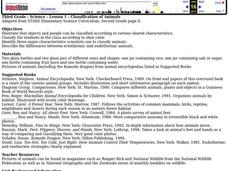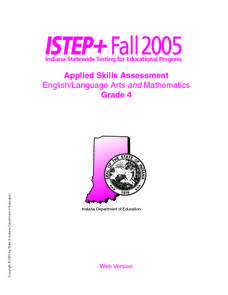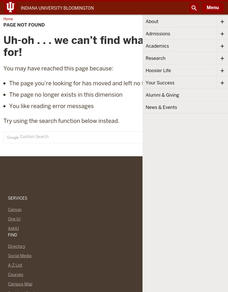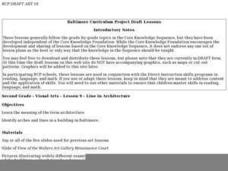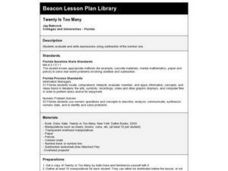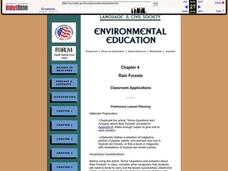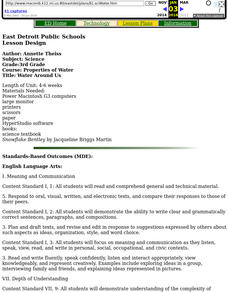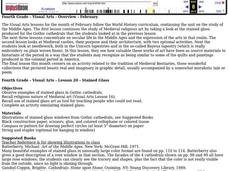Curated OER
TLC--Lesson Plans
Students in the grades kindergarten and 2nd grade interact with each other. They (2nd graders) faciliate one on one tutoring in the areas of reading and writing with the kindergartens. Students in the 2nd grade promote mentoring skills.
Curated OER
Growing a Winter Garden
Second graders listen to a planting story as read by their teacher. Using the text, they summarize the events and complete a KWL chart. They point to the vegetable after it was planted in the garden in the story. They practice using new...
Curated OER
Classification of Animals
Third graders practice classiyfying items and identify three major characteristics scientists use to classify animals. They describe the differences between ectothermic and endothermic animals.
Curated OER
Applied Skills Assessment
In this skills worksheet, 4th graders answer 48 questions from the Indiana Statewide Testing for Educational Progress in Language Arts and Mathematics.
Curated OER
Utah's American Indian Tribes Today
Seventh graders examine Utah's American Indian tribes and how they add to the diversity of cultures in Utah today.
Curated OER
Monster Dictionary
Third graders explore several retrieval strategies to find information in a variety of sources. They organize the information they find and create a Monster Dictionary that includes imaginary monsters and their definitions.
Curated OER
Meeting our Basic Needs
Students brainstorm the basic needs of the community and create a chart. In this volunteerism lesson, students recognize people in the community who have given charity in the community. Students read biographies of these charitable...
Curated OER
Childhood Through the Looking-Glass
Students learn about Lewis Carroll and the vision of childhood he created in Alice in Wonderland, then compare Carroll's Victorian world of childhood with the world of "Innocence and Experience" portrayed by the Romantic poet William Blake.
Curated OER
Good Prevails
Learners write descriptive paragraphs of characters after reading a Japanese folktale in which characters represent by good and evil.
Curated OER
Gingerbread Baby Final Activity #11
Students are read the story "Gingerbread Baby". They write their own letter to the author telling her about their favorite part. They ask questions and hopefully they will receive the answers from her as well.
Curated OER
Creating a Three-Dimesional Timeline
Pupils gather and order historical evidence surrounding the Silk Roads. They identify key people, places, and events in the history of the Silk Roads. They gain an understanding of the rich diversity of peoples and places found along the...
Curated OER
Visual Arts - Lesson 9 - Line in Architecture
Second graders study the meaning of the term architecture and identify arches and lines in a building in Balimore.
Curated OER
SUITE FOR ORCHESTRA NO.3
Students listen to a recording of Suite for Orchestra No. 3 by J. S. Bach, review and recognize basic musical instruments by sight, and begin to recognize sounds of some instruments.
Curated OER
Flora and Fauna as Figures of Speech
Students view artwork in manuscript pages depicting insects, animals, plants, flowers, and ornate writing, such as those found in the Mira calligraphiae monumenta in the Getty Museum.
Curated OER
Our Link To The Past
Young scholars explore how we are linked to the past and what that means. Inquires are made into the concept of history as the passage of time and changing seasons.
Curated OER
How - To - Posters
Students investigate the skills needed to survive for the early colonial settlers and Native Americans. They conduct research, develop a list of skills, and create a how-to poster demonstrating a survival skill.
Curated OER
Rain Forests
Students investigate rain forests. They view and discuss photos of rain forests, answer discussion questions, define key vocabulary words, and participate in a class discussion.
Curated OER
Make a Journal
Students decide what kind of journal they want to keep. They make the cover for their journal using construction paper and markers or paint and other types of art equipment like sequins.
Curated OER
The Crying Baby says Waa! Waa!
Students practice identifying and writing the letter "a." They say a tongue twister and identify the words with short letter "a" sounds. They then listen to the teacher read "A Cat Nap" and identify the words that have the "a" sound. ...
Curated OER
Alphabody ABCs of Giving
Students explore the concept of philanthropy. They develop a list of words about giving and kindness, alphabetize the words, and pantomime the words from the list.
Curated OER
Water Around Us
Third graders learn the effects of temperature on the states of water. Then students create paper snowflakes. Finally students complete a computer project with software which teaches the different states of water.
Curated OER
Visual Arts
Fourth graders study the stained glass produced for the Gothic cathedrals, needlework, castles, and tapestry of the Middle Ages.
Curated OER
Bones and Muscles
Third graders are introduced to bones as the body's means of support and protection. They research bone facts and conduct an experiment with chicken bones. They identify and observe involuntary muscles at work.




